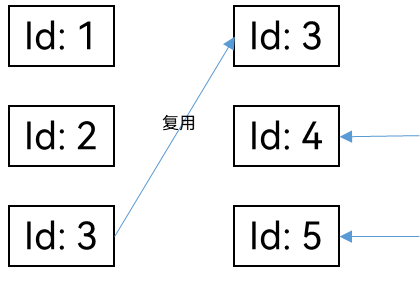harmony 鸿蒙ForEach:循环渲染
ForEach:循环渲染
ForEach基于数组类型数据执行循环渲染。
说明:
从API version 9开始,该接口支持在ArkTS卡片中使用。
接口描述
ForEach(
arr: Array,
itemGenerator: (item: Array, index?: number) => void,
keyGenerator?: (item: Array, index?: number): string => string
)
| 参数名 | 参数类型 | 必填 | 参数描述 |
|---|---|---|---|
| arr | Array | 是 | 必须是数组,允许设置为空数组,空数组场景下将不会创建子组件。同时允许设置返回值为数组类型的函数,例如arr.slice(1, 3),设置的函数不得改变包括数组本身在内的任何状态变量,如Array.splice、Array.sort或Array.reverse这些改变原数组的函数。 |
| itemGenerator | (item: any, index?: number) => void | 是 | 生成子组件的lambda函数,为数组中的每一个数据项创建一个或多个子组件,单个子组件或子组件列表必须包括在大括号“{…}”中。 说明: - 子组件的类型必须是ForEach的父容器组件所允许的(例如,只有当ForEach父级为List组件时,才允许ListItem子组件)。 - 允许子类构造函数返回if或另一个ForEach。ForEach可以在if内的任意位置。 - 可选index参数如在函数体中使用,则必须仅在函数签名中指定。 |
| keyGenerator | (item: any, index?: number) => string | 否 | 匿名函数,用于给数组中的每一个数据项生成唯一且固定的键值。键值生成器的功能是可选的,但是,为了使开发框架能够更好地识别数组更改,提高性能,建议提供。如将数组反向时,如果没有提供键值生成器,则ForEach中的所有节点都将重建。 说明: - 同一数组中的不同项绝对不能计算出相同的ID。 - 如果未使用index参数,则项在数组中的位置变动不得改变项的键值。如果使用了index参数,则当项在数组中的位置有变动时,键值必须更改。 - 当某个项目被新项替换(值不同)时,被替换的项键值和新项的键值必须不同。 - 在构造函数中使用index参数时,键值生成函数也必须使用该参数。 - 键值生成函数不允许改变任何组件状态。 |
使用限制
ForEach必须在容器组件内使用。
生成的子组件应当是允许包含在ForEach父容器组件中的子组件。
允许子组件生成器函数中包含if/else条件渲染,同时也允许ForEach包含在if/else条件渲染语句中。
itemGenerator函数的调用顺序不一定和数组中的数据项相同,在开发过程中不要假设itemGenerator和keyGenerator函数是否执行及其执行顺序。例如,以下示例可能无法正确运行:
let obj: Object ForEach(anArray.map((item1: Object, index1: number): Object => { obj.i = index1 + 1 obj.data = item1 return obj; }), (item: string) => Text(`${item.i}. item.data.label`), (item: string): string => { return item.data.id.toString() })
开发建议
建议开发者不要假设项构造函数的执行顺序。执行顺序可能不能是数组中项的排列顺序。
不要假设数组项是否是初始渲染。ForEach的初始渲染在\@Component首次渲染时构建所有数组项。后续框架版本中可能会将此行为更改为延迟加载模式。
使用 index参数对UI更新性能有严重的负面影响,请尽量避免。
如果项构造函数中使用index参数,则项索引函数中也必须使用该参数。否则,如果项索引函数未使用index参数,ForEach在生成实际的键值时,框架也会把index考虑进来,默认将index拼接在后面。
使用场景
简单ForEach示例
根据arr数据分别创建3个Text和Divide组件。
@Entry
@Component
struct MyComponent {
@State arr: number[] = [10, 20, 30];
build() {
Column({ space: 5 }) {
Button('Reverse Array')
.onClick(() => {
this.arr.reverse();
})
ForEach(this.arr, (item: number) => {
Text(`item value: ${item}`).fontSize(18)
Divider().strokeWidth(2)
}, (item: number) => item.toString())
}
}
}
复杂ForEach示例
@Component
struct CounterView {
@State label: string = "";
@State count: number = 0;
build() {
Button(`${this.label}-${this.count} click +1`)
.width(300).height(40)
.backgroundColor('#a0ffa0')
.onClick(() => {
this.count++;
})
}
}
@Entry
@Component
struct MainView {
@State arr: number[] = Array.from(Array(10).keys()); // [0.,.9]
nextUnused: number = this.arr.length;
build() {
Column() {
Button(`push new item`)
.onClick(() => {
this.arr.push(this.nextUnused++)
})
.width(300).height(40)
Button(`pop last item`)
.onClick(() => {
this.arr.pop()
})
.width(300).height(40)
Button(`prepend new item (unshift)`)
.onClick(() => {
this.arr.unshift(this.nextUnused++)
})
.width(300).height(40)
Button(`remove first item (shift)`)
.onClick(() => {
this.arr.shift()
})
.width(300).height(40)
Button(`insert at pos ${Math.floor(this.arr.length / 2)}`)
.onClick(() => {
this.arr.splice(Math.floor(this.arr.length / 2), 0, this.nextUnused++);
})
.width(300).height(40)
Button(`remove at pos ${Math.floor(this.arr.length / 2)}`)
.onClick(() => {
this.arr.splice(Math.floor(this.arr.length / 2), 1);
})
.width(300).height(40)
Button(`set at pos ${Math.floor(this.arr.length / 2)} to ${this.nextUnused}`)
.onClick(() => {
this.arr[Math.floor(this.arr.length / 2)] = this.nextUnused++;
})
.width(300).height(40)
ForEach(this.arr,
(item: string) => {
CounterView({ label: item.toString() })
},
(item: string) => item.toString()
)
}
}
}
MainView拥有一个\@State装饰的数字数组。添加、删除和替换数组项是可观察到的变化事件,当这些事件发生时,MainView内的ForEach都会更新。
项目索引函数为每个数组项创建唯一且持久的键值,ArkUI框架通过此键值确定数组中的项是否有变化,只要键值相同,数组项的值就假定不变,但其索引位置可能会更改。此机制的运行前提是不同的数组项不能有相同的键值。
使用计算出的ID,框架可以对添加、删除和保留的数组项加以区分:
框架将删除已删除数组项的UI组件。
框架仅对新添加的数组项执行项构造函数。
框架不会为保留的数组项执行项构造函数。如果数组中的项索引已更改,框架将仅根据新顺序移动其UI组件,但不会更新该UI组件。
建议使用项目索引函数,但这是可选的。生成的ID必须是唯一的,这意味着不能为数组中的不同项计算出相同的ID。即使两个数组项具有相同的值,其ID也必须不同。
如果数组项值更改,则ID必须更改。 如前所述,id生成函数是可选的。以下是不带项索引函数的ForEach:
let list: Object
ForEach(this.arr,
(item: Object): string => {
list.label = item.toString();
CounterView(list)
}
)
如果没有提供项ID函数,则框架会尝试在更新ForEach时智能检测数组更改。但是,它可能会删除子组件,并为在数组中移动(索引被更改)的数组项重新执行项构造函数。在上面的示例中,这将更改应用程序针对CounterView counter状态的行为。创建新的CounterView实例时,counter的值将初始化为0。
使用\@ObjectLink的ForEach示例
当需要保留重复子组件的状态时,\@ObjectLink可将状态在组件树中向父组件推送。
let NextID: number = 0;
@Observed
class MyCounter {
public id: number;
public c: number;
constructor(c: number) {
this.id = NextID++;
this.c = c;
}
}
@Component
struct CounterView {
@ObjectLink counter: MyCounter;
label: string = 'CounterView';
build() {
Button(`CounterView [${this.label}] this.counter.c=${this.counter.c} +1`)
.width(200).height(50)
.onClick(() => {
this.counter.c += 1;
})
}
}
@Entry
@Component
struct MainView {
@State firstIndex: number = 0;
@State counters: Array<MyCounter> = [new MyCounter(0), new MyCounter(0), new MyCounter(0),
new MyCounter(0), new MyCounter(0)];
build() {
Column() {
ForEach(this.counters.slice(this.firstIndex, this.firstIndex + 3),
(item: MyCounter) => {
CounterView({ label: `Counter item #${item.id}`, counter: item })
},
(item: MyCounter) => item.id.toString()
)
Button(`Counters: shift up`)
.width(200).height(50)
.onClick(() => {
this.firstIndex = Math.min(this.firstIndex + 1, this.counters.length - 3);
})
Button(`counters: shift down`)
.width(200).height(50)
.onClick(() => {
this.firstIndex = Math.max(0, this.firstIndex - 1);
})
}
}
}
当增加firstIndex的值时,Mainview内的ForEach将更新,并删除与项ID firstIndex-1关联的CounterView子组件。对于ID为firstindex + 3的数组项,将创建新的CounterView子组件实例。由于CounterView子组件的状态变量counter值由父组件Mainview维护,故重建CounterView子组件实例不会重建状态变量counter值。
说明:
违反上述数组项ID规则是最常见的应用开发错误,尤其是在Array<number>场景下,因为执行过程中很容易添加重复的数字。
ForEach的嵌套使用
允许将ForEach嵌套在同一组件中的另一个ForEach中,但更推荐将组件拆分为两个,每个构造函数只包含一个ForEach。下面为ForEach嵌套使用反例。
class Month {
year: number;
month: number;
days: number[];
constructor(year: number, month: number, ...days: number[]) {
this.year = year;
this.month = month;
this.days = days;
}
}
@Component
struct CalendarExample {
// 模拟6个月
arr28: Array<number> = Array(31).fill(0).map((_: number, i: number): number => i + 1);
arr30: Array<number> = Array(31).fill(0).map((_: number, i: number): number => i + 1);
arr31: Array<number> = Array(31).fill(0).map((_: number, i: number): number => i + 1);
@State calendar : Month[] = [
new Month(2020, 1, ...(this.arr31)),
new Month(2020, 2, ...(this.arr28)),
new Month(2020, 3, ...(this.arr31)),
new Month(2020, 4, ...(this.arr30)),
new Month(2020, 5, ...(this.arr31)),
new Month(2020, 6, ...(this.arr30))
]
build() {
Column() {
Button() {
Text('next month')
}.onClick(() => {
this.calendar.shift()
this.calendar.push(new Month(2020, 7, ...(this.arr31)))
})
ForEach(this.calendar,
(item: Month) => {
ForEach(item.days,
(day : number) => {
// 构建日期块
},
(day : number) => day.toString()
)// 内部ForEach
},
(item: Month) => (item.year * 12 + item.month).toString() // 字段与年和月一起使用,作为月份的唯一ID。
)// 外部ForEach
}
}
}
以上示例存在两个问题:
代码可读性差。
对于上述的年月份数据的数组结构形式,由于框架无法观察到针对该数组中Month数据结构的改变(比如day数组变化),从而内层的ForEach无法刷新日期显示。
建议应用设计时将Calendar拆分为Year、Month和Day子组件。定义一个“Day”模型类,以保存有关day的信息,并用\@Observed装饰此类。DayView组件利用ObjectLink装饰变量以绑定day数据。对MonthView和Month模型类执行同样的操作。
ForEach中使用可选index参数示例
可以在构造函数和ID生成函数中使用可选的index参数。
@Entry
@Component
struct ForEachWithIndex {
@State arr: number[] = [4, 3, 1, 5];
build() {
Column() {
ForEach(this.arr,
(it: number, index) => {
Text(`Item: ${index} - ${it}`)
},
(it: number, index) => {
return `${index} - ${it}`
}
)
}
}
}
必须正确构造ID生成函数。当在项构造函数中使用index参数时,ID生成函数也必须使用index参数,以生成唯一ID和给定源数组项的ID。当数组项在数组中的索引位置发生变化时,其ID会发生变化。
此示例还说明了index参数会造成显著性能下降。即使项在源数组中移动而不做修改,因为索引发生改变,依赖该数组项的UI仍然需要重新渲染。例如,使用索引排序时,数组只需要将ForEach未修改的子UI节点移动到正确的位置,这对于框架来说是一个轻量级操作。而使用索引时,所有子UI节点都需要重新构建,这操作负担要重得多。
常见问题
在ForEach数据源中添加元素导致ID重复
在ForEach数据源中添加元素导致数组项ID重复。
【反例】
下面示例使用ForEach方法迭代数组this.arr的每个元素,在Text组件进行显示,并在单击Text(‘Add arr element’)时添加新的数组元素。
@Entry
@Component
struct Index {
@State arr: number[] = [1,2,3];
build() {
Column() {
ForEach(this.arr,
(item: void) => {
Text(`Item ${item}`)
},
(item: string) => item.toString())
Text('Add arr element')
.fontSize(20)
.onClick(()=>{
this.arr.push(4); // arr新增的元素,其在ForEach内的键值均为'4'
console.log("Arr elements: ", this.arr);
})
}
}
}
点击两次Text(’Add arr element’)时,数组this.arr每次都会添加新元素 4。但是在ForEach循环渲染中,第三个参数(item)=> item.toString()需要生成Array每一个item对应的id值。该Array Id被要求是唯一的和稳定的。
唯一性:键值生成函数生成的每个数组项的id是不同的。
稳定性:当数组项ID发生变化时,ArkUI框架认为该数组项被替换或更改。
ArkUI框架会对重复的ID告警,这种情况下框架的行为是未知的,特别是UI的更新在该场景下可能不起作用。
因此上述示例中,框架不会显示第二次及以后新添加的文本元素。因为这个元素不再是唯一的,他们都含有相同的id4。 但是如果删除ForEach第三个键值生成函数(item) => item.toString(),则触发onClick事件后每一个新添加的Text元素都会得到更新。这是因为框架使用了默认的Array id生成函数,即(item: any, index : number) => ‘${index}__${JSON.stringify(item)}‘。它的兼容性更好但可能会导致不必要的UI更新,因此仍建议应用定义自己的键值生成函数。
ForEach数据源更新未创建新数组项
ForEach数据源更新时,数组项ID与原数组项ID重复不会重新创建该数组项。
【反例】
下面的示例定义了Index和Child两个组件。父组件Index有arr数组成员变量,初始值包含数字1、2、3。Child定义\@Prop value,接收父组件中arr数组中的一个元素。
@Component
struct Child {
@Prop value: number = 0;
build() {
Text(`${this.value}`)
.fontSize(50)
.onClick(() => {
this.value++ // 点击改变@Prop的值
})
}
}
@Entry
@Component
struct Index {
@State arr: number[] = [1, 2, 3];
build() {
Row() {
Column() {
// 对照组
Child({ value: this.arr[0] })
Child({ value: this.arr[1] })
Child({ value: this.arr[2] })
Divider().height(5)
ForEach(this.arr,
(item: number) => {
Child({ value: item })
},
(item: string) => item.toString() // 键值,标识id
)
Text('Parent: replace entire arr')
.fontSize(50)
.onClick(() => {
// 两个数组项内均含有'3',ForEach内的id没有发生变化
// 意味着ForEach不会更新该Child实例,@Prop也不会在父组件处被更新
this.arr = (this.arr[0] == 1) ? [3, 4, 5] : [1, 2, 3];
})
}
}
}
}
当触发文本组件Parent: replace entire arr的onClick事件时,状态变量数组arr根据自身第一个元素的值将被[3, 4, 5]或[1, 2, 3]替换,但是ForEach里初始被创建的\@Prop传入值为3的Child组件并不会更新。
因为,老数组和新数组初始均含有同一个值的元素(数字3),而且该元素生成的标识id在父组件里没有变化。因此ForEach没有识别出对应的Child实例需要被新的输入值更新,对应的子组件内\@Prop也没有更新。

可以在arr中用一个唯一的元素代替重复的元素3来观察本事件的行为表现。当恰当的替换掉数组时,接下来应用的表现才是符合预期的。
你可能感兴趣的鸿蒙文章
- 所属分类: 后端技术
- 本文标签: